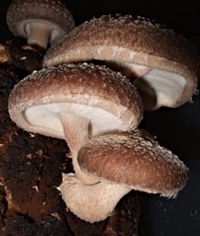 Lentinula edodes or popularly known as Shiitake Mushroom is a native to East Asia and considered as leader of mushroom which was used for edible and medicinal purposes in many Asian countries.
Lentinula edodes or popularly known as Shiitake Mushroom is a native to East Asia and considered as leader of mushroom which was used for edible and medicinal purposes in many Asian countries.
Shiitake Mushroom is a source of well known antitumor or polysaccharides lentinan from the fruiting body or mycelia. It respond actively affecting cholesterol, triglyceride and phospolipid level. Bag Cultivation of Shiitake can produced fruiting bodies faster and the yield is higher compared to log cultivation. The use of different agricultural wastes as substrate is one of the advantages in Shiitake Bag Cultivation. However, cropping period is 6 months compared to 4 to 6 years of wood logs.
Shiitake Mushroom Production Guide
SPAWN PREPARATION
The basic material in grain spawn is sorghum or any cereal seeds. Wash grains thoroughly and discard all floated seeds. Boil for at least 20 – 25 minutes. Collect seeds using strainer to drain the water and spread out on newspaper or manila paper to absorb the excess water . Transfer the boiled grains in round bottle (e.g. catsup or Gatorade), plug with cotton waste and cover with clean paper. Sterilize the bottled grains at 15 psi for one hour. Cool down. When cooled, pure culture stubs of shiitake will be inoculated in the sterilized bottled grains. Incubate for 14-21 days. This serves as grain spawn. Use the grain spawn to inoculate sterilized fruiting bags.
PREPARATION OF FRUITING SUBSTRATE
A. Mixing and Fermentation
Combine rice bran (9%), rice straw (5%), sawdust (79.6%), gypsum (1.8%), sugar or molasses (1.8%), lime (0.9%), pumice (1.8%), Magnesium sulphate (0.1%). Moisten and pile into heap (moisture content is about 60%). Cover with plastic sheets and turn evenly the heap materials every 2-3 days for 15-21 days. However, if old sawdust and stored under open space is to be used, fermentation is no longer needed.
B. Filling the Bags
Use plastic bags of 6×12 inches polypropylene plastic (PP) bags size 0.3 mm. Fill 800g of fermented substrate materials in the pp bags and then compress. Then put pvc pipe neck plug with cotton waste, cover with clean paper or plastic cap to minimize entry of water during steaming or pasteurization.
C. Pasteurization or Steaming
Steam the bags in a pasteurizer like drum for 6 – 8 hours and cool down. Provide drums with cover that fits tightly on top. Provide racks to hold the bags inside the drum. Another method is sterilizing the bags in an autoclave or pressure cooker for 1 and 1/2 hours at 15 psi.
D. Inoculating the Bags
Inoculate each bag with the grain spawn in a clean and aspetic place. To inoculate, shake the grain spawn bottle to loosen the grains, remove the plug and flame the mouth of the bottle and pour some grains into the bags. Slightly shake the neck area of newly inoculated bags to distribute evenly the grains in the shoulder area of the bags.
E. Incubation
Keep the spawned bags in a dry and ventilated room with 4hr/20hr/ light dark cycle for at least 60-90 days. Fully colonized bags may begin to turn brown and produces some exudates. This is normal and considered desirable. Five stages during mycelia development may be observed; mycelial running, the mycelia turned into white; mycelia coat formation, the thickening of white mycelia around the bags; mycelia bump formation, the bags produces exudates or bumps can turn into primordial at a larger stage. At pigmentation phase, the mycelium will turn reddish-brown and coat hardening phase, the bags have partially produces primordial and the outside of the substrate (coat) will have gradually became hard. The brown hard skin acts like the bark in wood log production.
SHOCKING OR FORCING PRODUCTION METHOD
Shocking or Forcing is the process used to induced mycelium to form fruiting bodies (mushroom) production. Soaking the bags in cold water is the most typically means to induce fruiting. Gently roll down and take off the PP plastic sheet of the bags and place in soaking containers and leave for 24-48 hrs. Then remove the bags from the water and place the soaked bags in a cold dim area. Continuously water the bags. In 5-7 days, pinhead will appear.
FRUITING REQUIREMENT
Fruiting requires a temperature of 17 ° C to 22 ° C with ventilation, light, and relative humidity (85-95%). Provide moisture by watering the mush-room house daily. To lower the temperature and hasten the fruiting, spray the house using water not to exceed the temperature requirement.
For more information, please visit or call:
Bureau of Plant Industry – Crop Research Production
Support Division – Mushroom Culture Laboratory
692 San Andres Street Malate, Manila, Philippines
Phone: (02) 525-7403
Fax: (02) 521-7650
Mobile: (0919)991-3360
E-mail: [email protected]
or [email protected]
Acknowledgement: Mary Ann B. Guerrero; Julie Ann A. Aragones;Hazel Joy A. Nono; Mark Jay A. Nono; Vivencio R. Mamaril, Ph.D; Lina C. Lapitan Florencio C. Abarquez; Anita Perido
Source: www.bpi.da.gov.ph / Photo: en.wikipedia.org